
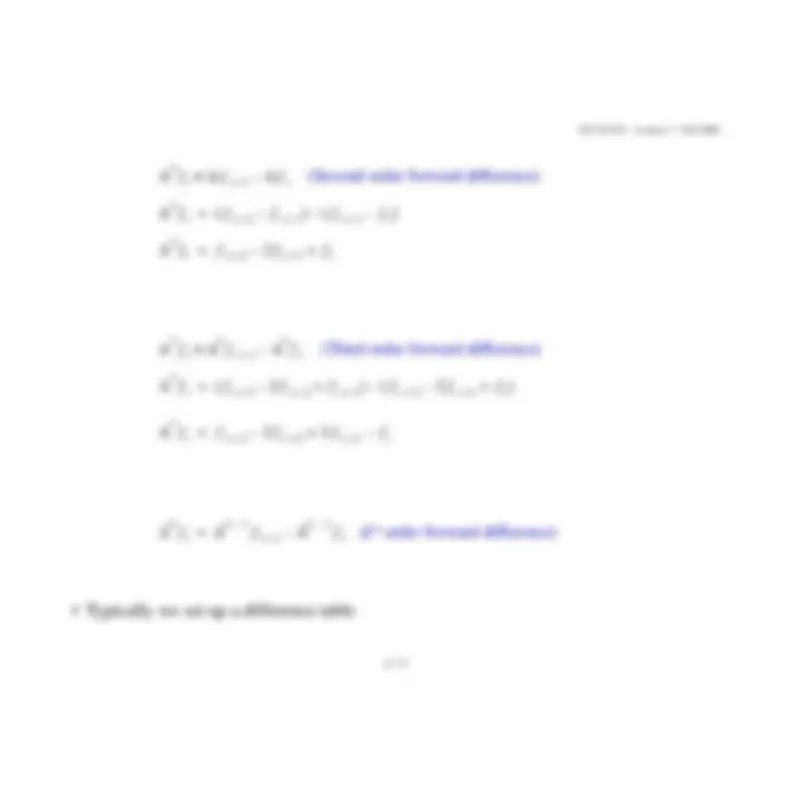


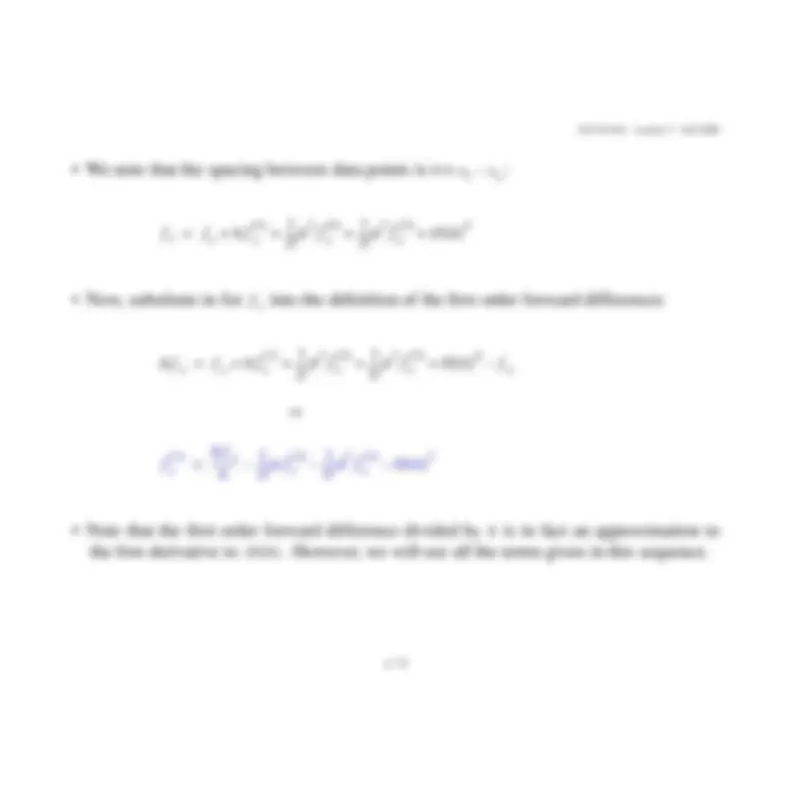
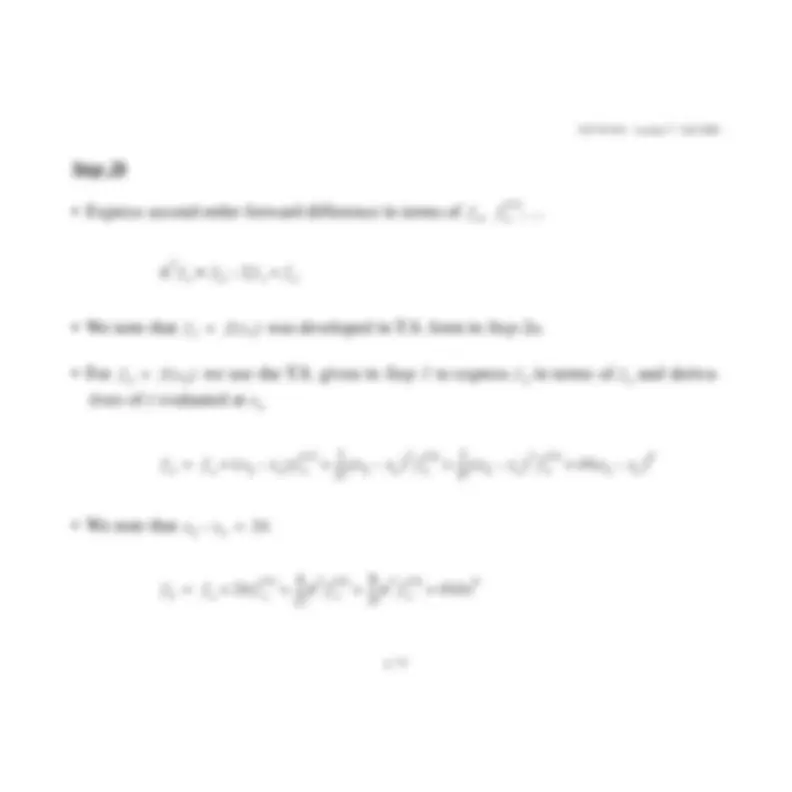
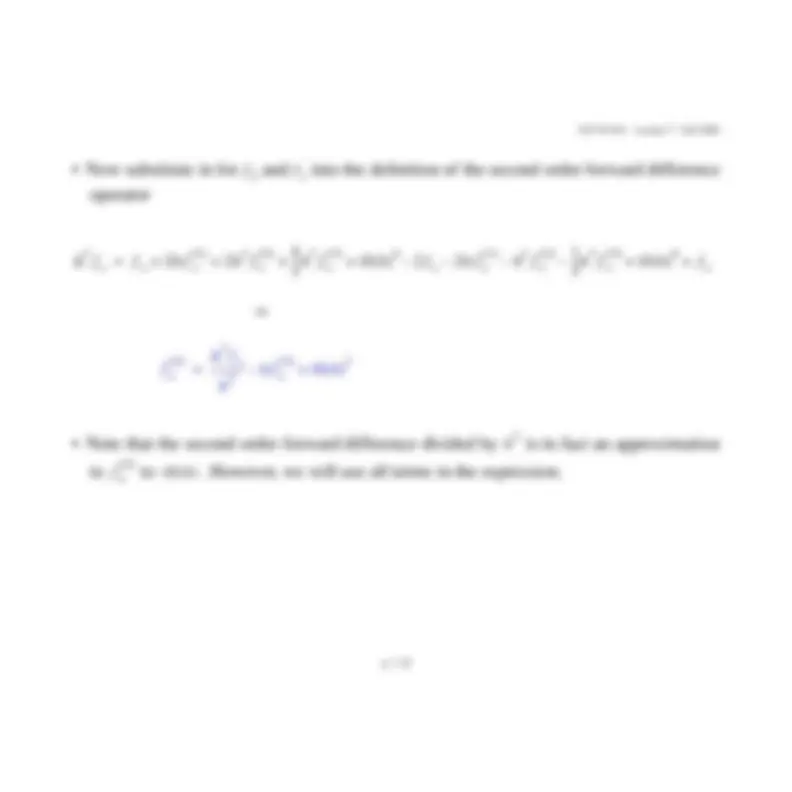
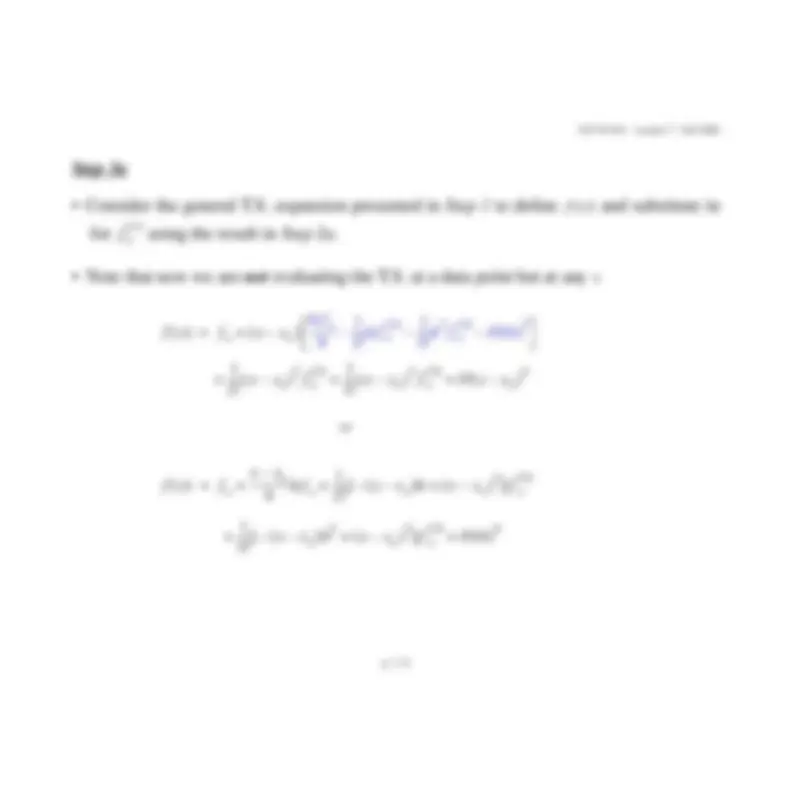
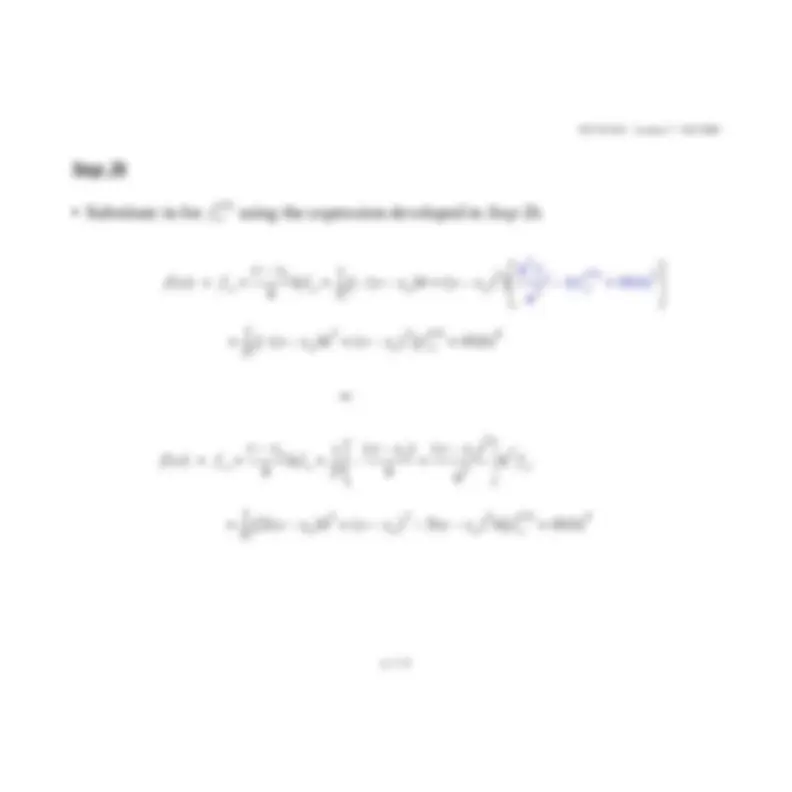
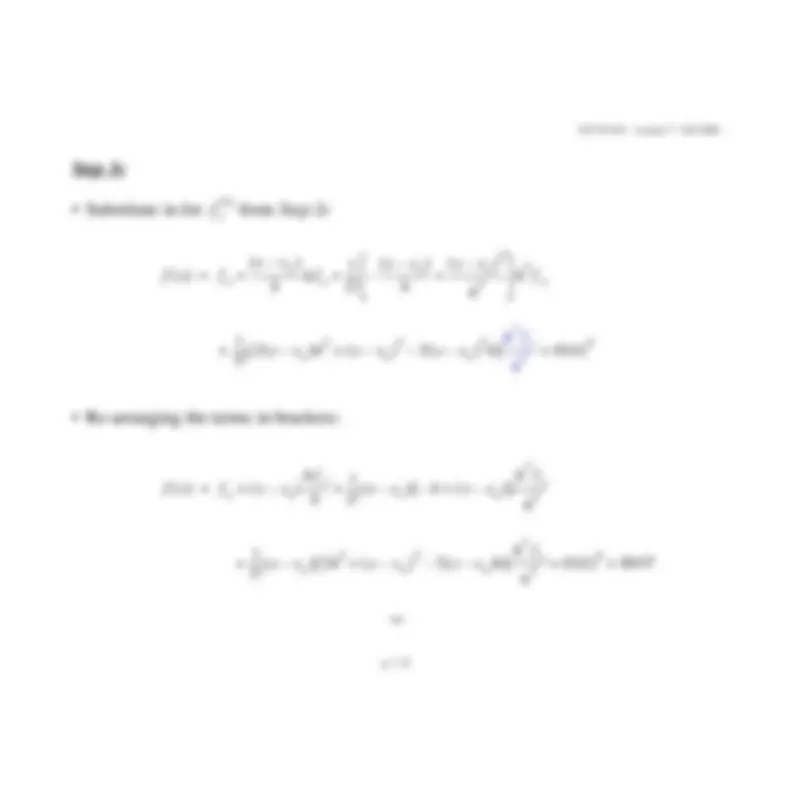
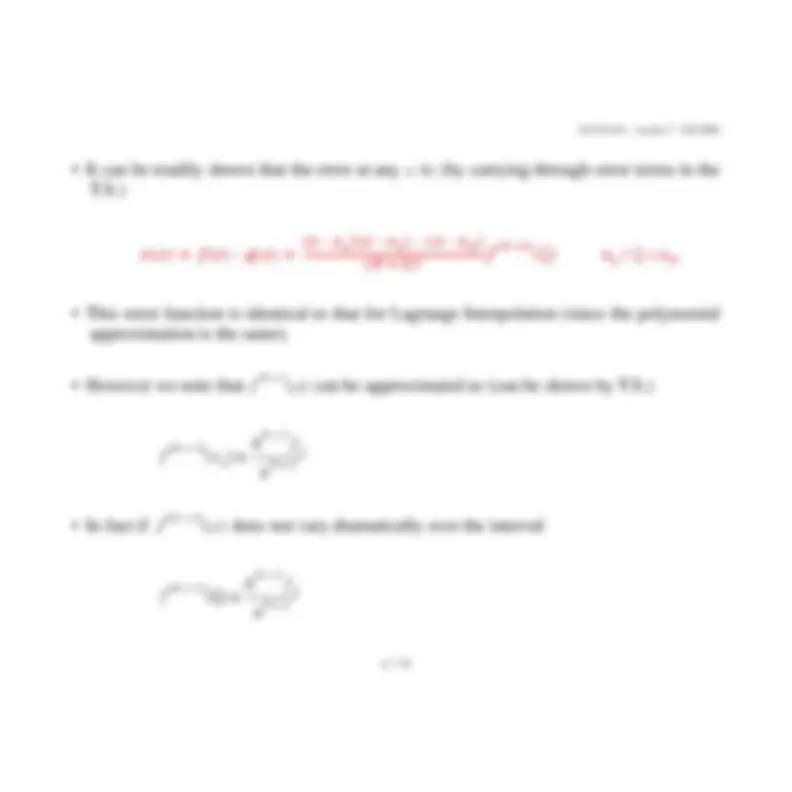
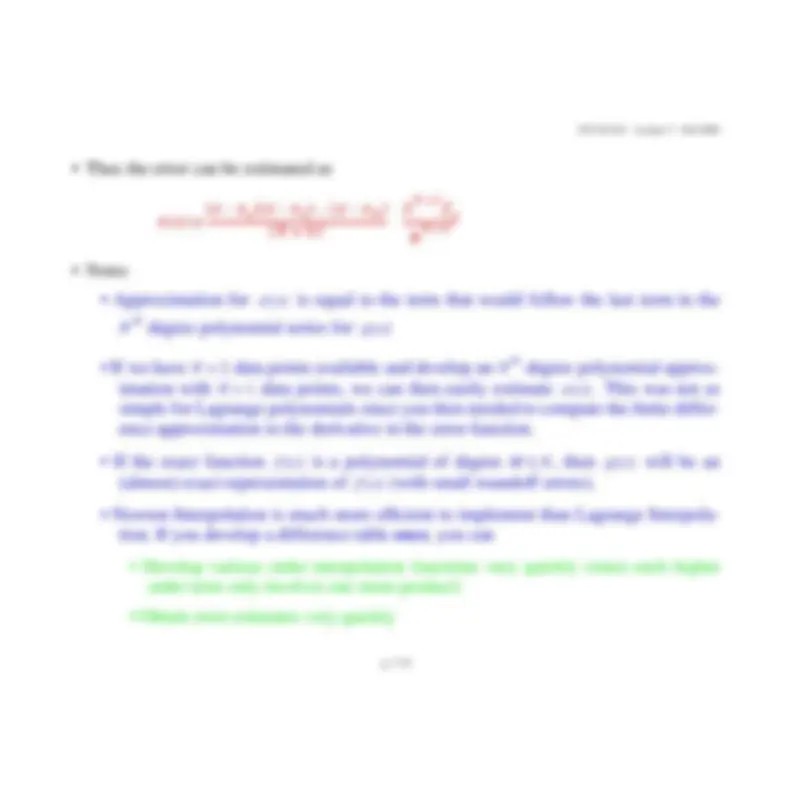
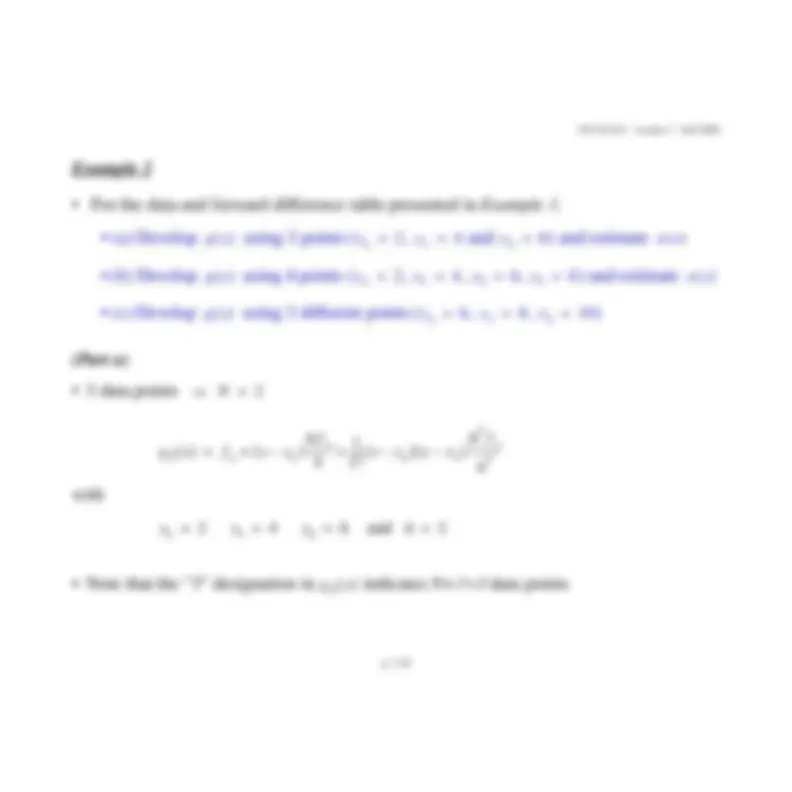
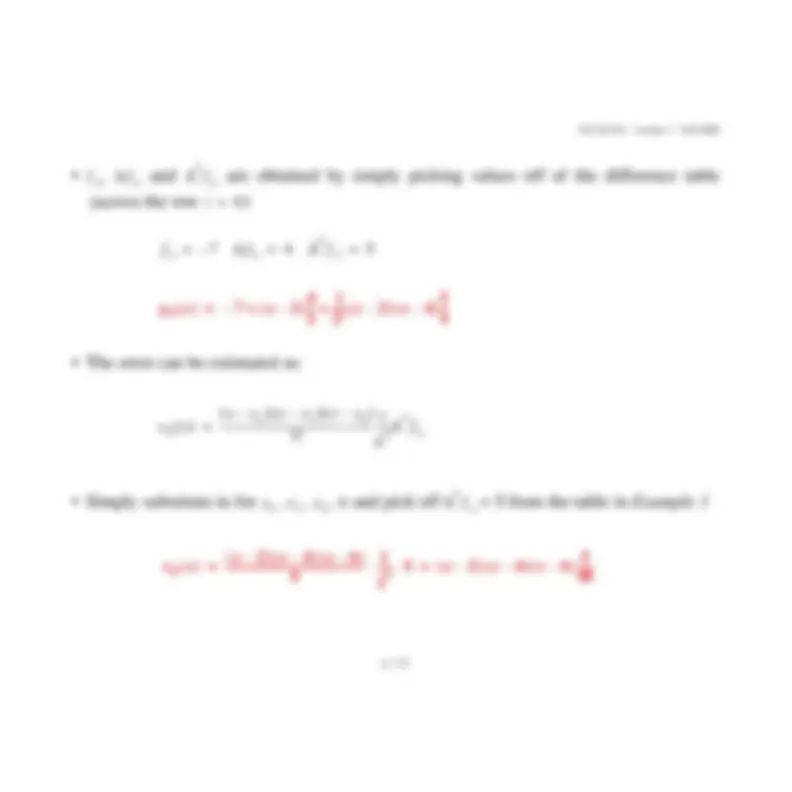
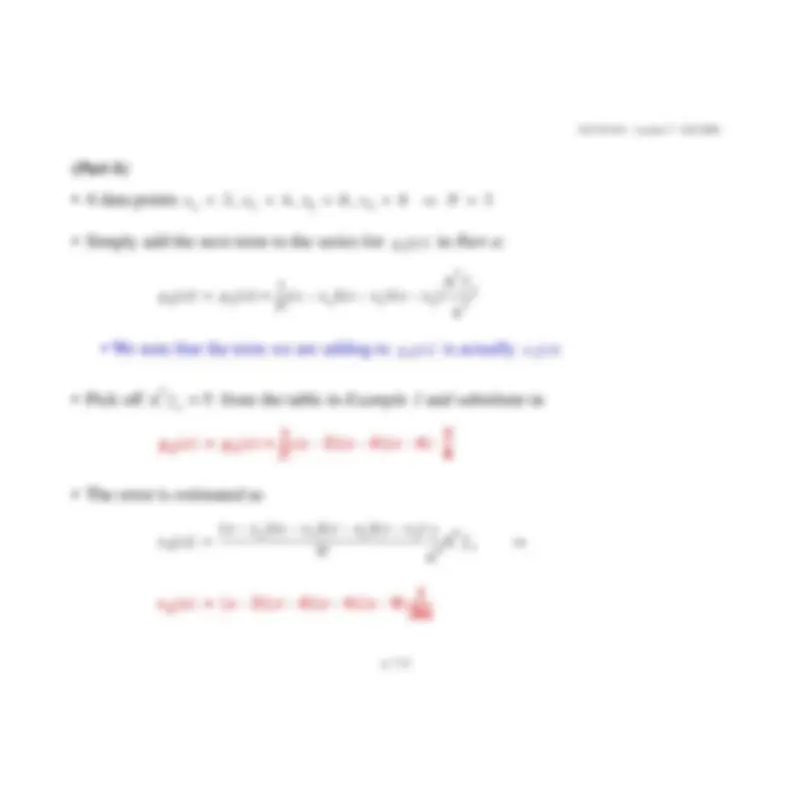
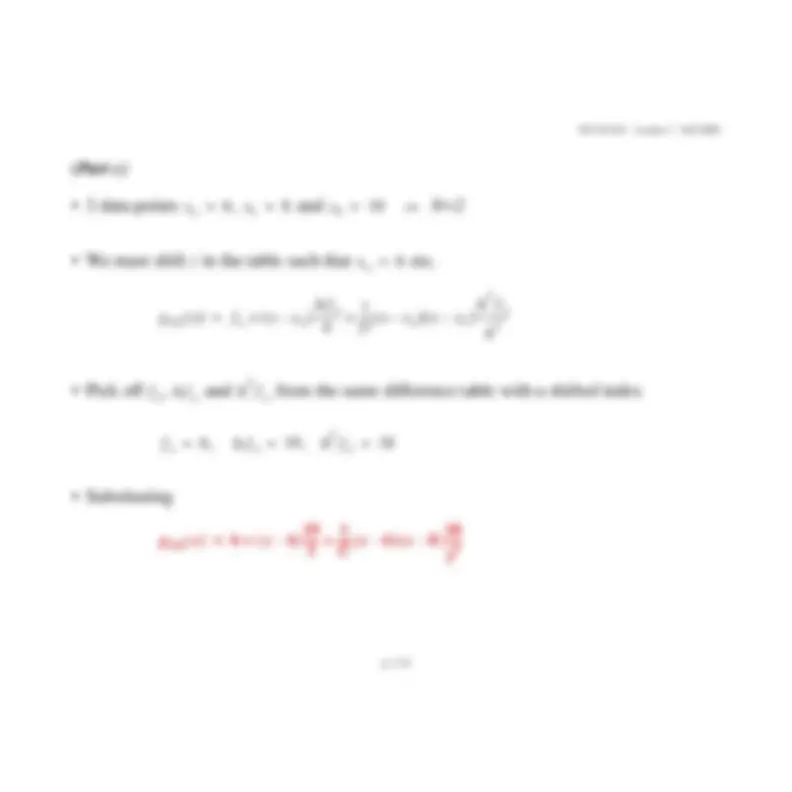
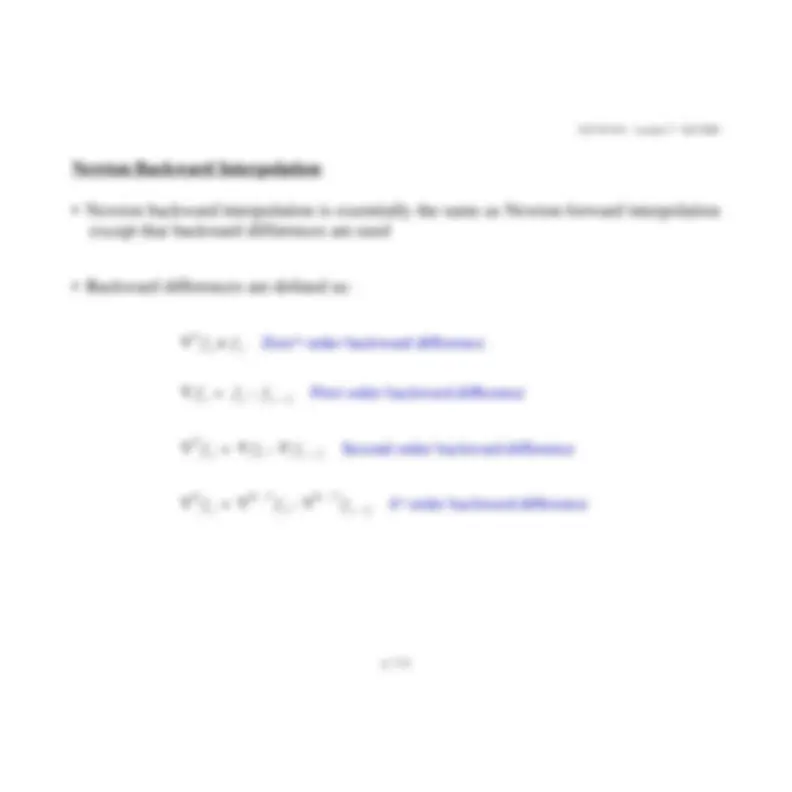
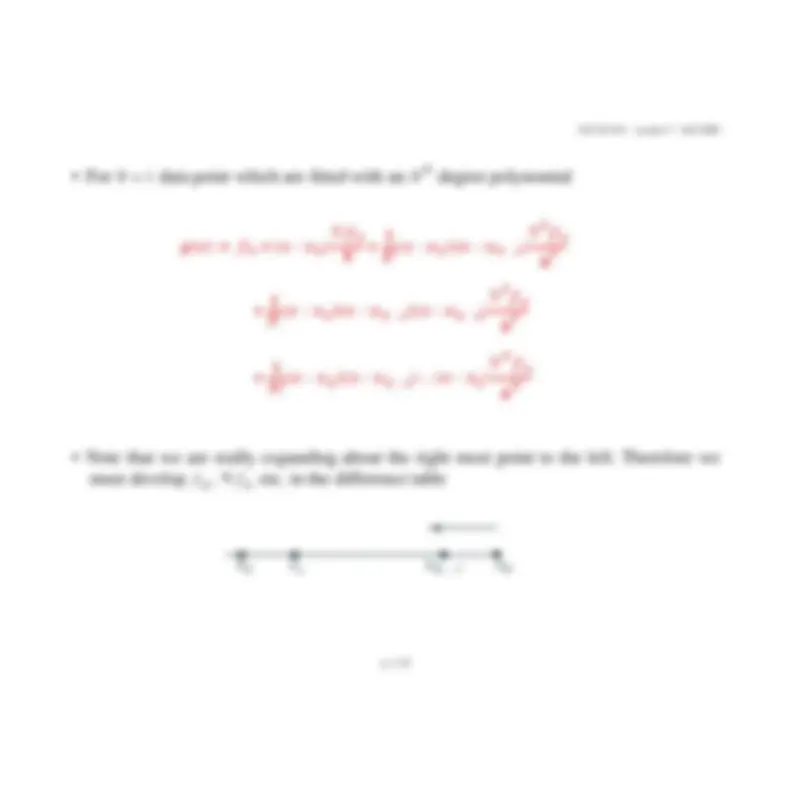
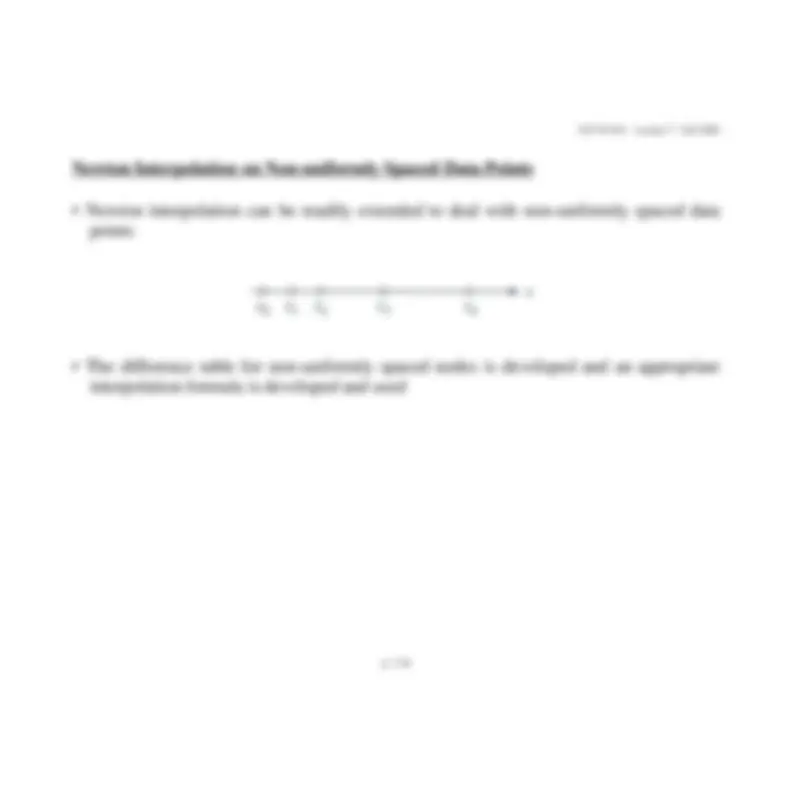



Study with the several resources on Docsity

Earn points by helping other students or get them with a premium plan


Prepare for your exams
Study with the several resources on Docsity

Earn points to download
Earn points by helping other students or get them with a premium plan
Community
Ask the community for help and clear up your study doubts
Discover the best universities in your country according to Docsity users
Free resources
Download our free guides on studying techniques, anxiety management strategies, and thesis advice from Docsity tutors
Newton Forward Interpolation, Forward Difference Tables, Zeroth Order Forward Difference, First Order Forward Difference, Second Order Forward Difference, Third Order Forward Difference, Kth Order Forward Difference, Newton Forward Interpolation, Newton Backward Interpolation
Typology: Slides
1 / 27

This page cannot be seen from the preview
Don't miss anything!




















CE 341/441 - Lecture 7 - Fall 2004
p. 7.
x
th
CE 341/441 - Lecture 7 - Fall 2004
p. 7.
th^
x^0
f^1
= f(x
f^
f^2
= f(x
f^3
= f(x
f^0
= f(x
fN
= f(x
N^
x^1
x^2
x^3
xN
x
h = interval size
(i)
0 f^ i
f^ i ≡
∆
f^
i^
f^ i
1 +^
f^ i
CE 341/441 - Lecture 7 - Fall 2004
p. 7.
f^ i
f^
i^
2
f^ i
3
f^ i
4 f^ i
f^ o
f^
o^
f^^1
f^ o
2 f^ o
f^
1
f^
o
3 f^ o
2
f^^1
2
f^ o
4 f^ o
3 f^^1
3 f^ o
f^^1
f^
1
f^^2
f^^1
2 f^^1
f^
2
f^
1
3 f^^1
2
f^^2
2
f^^1
f^^2
f^
2
f^^3
f^^2
2 f^^2
f^
3
f^
2
f^^3
f^
3
f^^4
f^^3
f^^4
x^ o
x^ N
,^
th
CE 341/441 - Lecture 7 - Fall 2004
p. 7.
i^
x^ i
f^ i
f^
i^
2 f^ i
3 f^ i
4 f^ i
5 f^ i
CE 341/441 - Lecture 7 - Fall 2004
p. 7.
⇒
f^
x ( )
x^ o
f^
x ( )
f^
x^ ( o
x^
x^ o
(^
df ) ----- dx
x^
x
x^ o
(^
d
2 f d x
x^
x
x^ o
(^
d
3 f d x
x^
O x
x^ o
(^
f^
x ( )
f^ o
x^
x^ o
(^
)^ f
(^1) ( (^) o )^
x
x^ o
(^
f^
(^2) ( (^) o )^
x
x^ o
(^
f^
(^3) ( (^) o )^
O x
x^ o
(^
f^ o
f^ o
(^1) ( )
f^
o^
f^^1
f^ o
≡
f^^1
f^
x ( 1
f^^1
f^ o f ^1
f^ o
x^1
x^ o
(^
f^ o
(^1) ( )
x
1
x^ o
(^
f^
(^2) ( (^) o )^
x^1
x^ o
(^
f^
(^3) ( (^) o )^
O x
1
x^ o
(^
CE 341/441 - Lecture 7 - Fall 2004
p. 7.
⇒
h^
x^1
x^ o
≡
f^^1
f^ o
h f
(^1) ( (^) o )^
h 2 f^ o
(^2) ( )
h 3 f^ o
(^3) ( )
O h
f^^1
f^
o^
f^ o
h f
(^1) ( (^) o )^
h 2 f^ o
(^2) ( )
h 3 f^ o
(^3) ( )
O h
f^ o
f^ o
(^1) ( )
f^
o h
h f
(^2) ( (^) o )^
(^2) h f^
(^3) ( (^) o )^
O h
h
O h
CE 341/441 - Lecture 7 - Fall 2004
p. 7.
⇒
f^^2
f^^1
2
f^ o
f^ o
h f
(^1) ( (^) o )^
h 2 f^ o
(^2) ( )
(^3) h f^
(^3) ( (^) o )^
O h
f^ o
-^
h f
(^1) ( (^) o )^
(^2) h f^
(^2) ( (^) o )^
h 3 f^ o
(^3) ( )
O h
f^ o
f^ o
(^2) ( )
2 f^ o h 2
h f
(^3) ( (^) o )^
O h
h 2
f^ o
(^2) ( )
O h
CE 341/441 - Lecture 7 - Fall 2004
p. 7.
f^ o
f^ o
(^1) ( )
3 f^ o
f^^3
f^^2
f^^1
f^ o
f^^2
f^^1
f^^3
f^
x ( 3
f^^3
f^ o
x^3
x^ o
(^
f^ o
(^1) ( )
x
3
x^ o
(^
f^
(^2) ( (^) o )^
x^3
x^ o
(^
f^
(^3) ( (^) o )^
O x
3
x^ o
(^
x^3
x^ o
-^
f^^3
f^ o
h f
(^1) ( (^) o )^
(^2) h f^
(^2) ( (^) o )^
h 3 f^ o
(^3) ( )
O h
CE 341/441 - Lecture 7 - Fall 2004
p. 7.
⇒
f^
x ( )
f^ o
(^1) ( )
x
f^
x ( )
f^ o
x^
x^ o
(^
f^
o h
h f
(^2) ( (^) o )^
h 2 f^ o
(^3) ( )
O h
x
x^ o
(^
f^
(^2) ( (^) o )^
x^
x^ o
(^
f^
(^3) ( (^) o )^
O x
x^ o
(^
f^
x ( )
f^ o
x^
x^ o
-^ h -------------
f^
o
x^
x^ o
(^
) h
x^
x^ o
(^
]^ f
(^2) ( (^) o )
x^
x^ o
(^
) h
2
x^
x^ o
(^
]^ f
(^3) ( (^) o )^
O h
CE 341/441 - Lecture 7 - Fall 2004
p. 7.
⇒
f^ o
(^2) ( )
f^
x ( )
f^ o
x^
x^ o
-^ h -------------
f^
o
x^
x^ o
(^
) h
x^
x^ o
(^
2 f^ o h 2
h f
(^3) ( (^) o )^
O h
x^
x^ o
(^
h 2
x^
x^ o
(^
f^ o
(^3) ( )
O h
f^
x ( )
f^ o
x^
x^ o
-^ h -------------
f^
o
x^
x^ o
(^
x^
x^ o
(^
(^2) h
2 f^ o
x
x^ o
(^
) h
2
x^
x^ o
(^
x^
x^ o
(^
h
f^ o
(^3) ( )
O h
CE 341/441 - Lecture 7 - Fall 2004
p. 7.
f^
x ( )
f^ o
x^
x^ o
(^
f^
o h
x^
x^ o
(^
x^
x^ o
h
(^
2 f^ o (^2) h
x
x^ o
(^
x^
x^ o
h
(^
x^
x^ o
h
(^
3 f^ o (^3) h
O h
x^ o
h
x^ o
h
f^
x (
g x
e x (
g x
f^ o
x^
x^ o
(^
f o h ---------
x
x^ o
(^
x^
x 1
(^
2 f^ o h 2 -----------
x
x^ o
(^
x^
x^1
(^
x^
x^2
(^
3
f^ o h
3 -----------
x^
x^ o
(^
x^
x^1
(^
x^
x 2
(^
x^
x^ N
1
(^
N^
f^ o h
N -------------
th
CE 341/441 - Lecture 7 - Fall 2004
p. 7.
⇒ ⇒
g x
g x
o (^
g x
1 (^
f^ o
x^1
x^ o
(^
f^^1
f^ o
f^ o
h^
f^^1
f^ o
f^^1
g x
2 (^
f^ o
x^2
x^ o
(^
f^^1
f^ o
x^2
x^ o
(^
x^2
x^1
(^
(^1) -----^2 h
f^^2
f^^1
f^ o
g x
2 (^
f^ o
2 h ----- h
f^^1
f^ o
(^
h (^
) h 2 h 2
f^^2
f^^1
f^ o
g x
2 (^
f^ o
f^^1
f^ o
-^
f^^2
f^^1
-^
f^ o
f^^2
g x
i (^
f^ i =
i^
CE 341/441 - Lecture 7 - Fall 2004
p. 7.
e x (
x^
x^ o
(^
x^
x 1
(^
x
x^ N
(^
N^
1 +^
f^ o
h
N
1 +
--------------------
e x (
th
g x
th
e x (
f^
x (
g x
f^
x ( )
CE 341/441 - Lecture 7 - Fall 2004
p. 7.
⇒
g x
x^ o
x^1
x^2
e x (
g x
x^ o
x^1
x^2
x^3
e x (
g x
x^ o
x^1
x^2
g 3
x ( )
f^ o
x^
x^ o
(^
f^
o h
x
x^ o
(^
x^
x^1
(^
2 f^ o (^2) h
x^ o
x^1
x^2
h^
g 3
x ( )